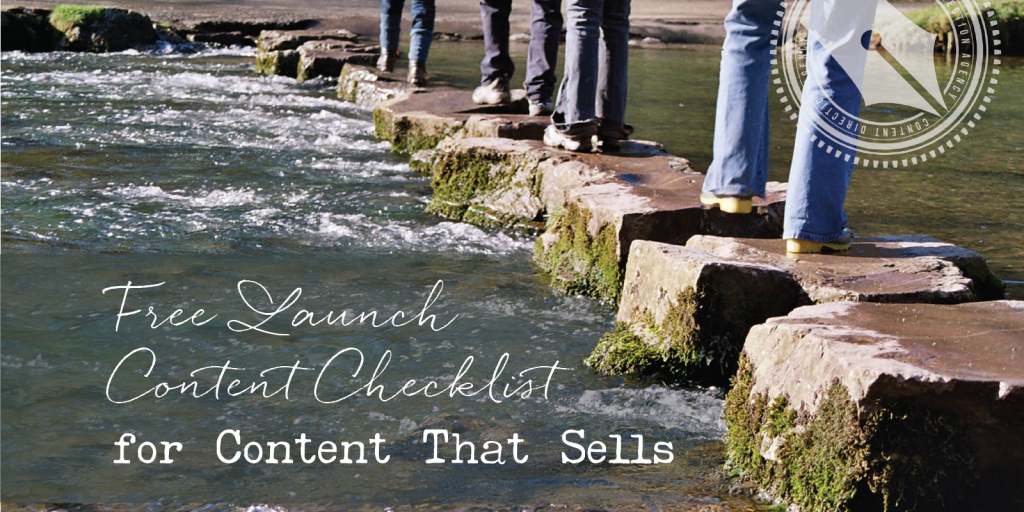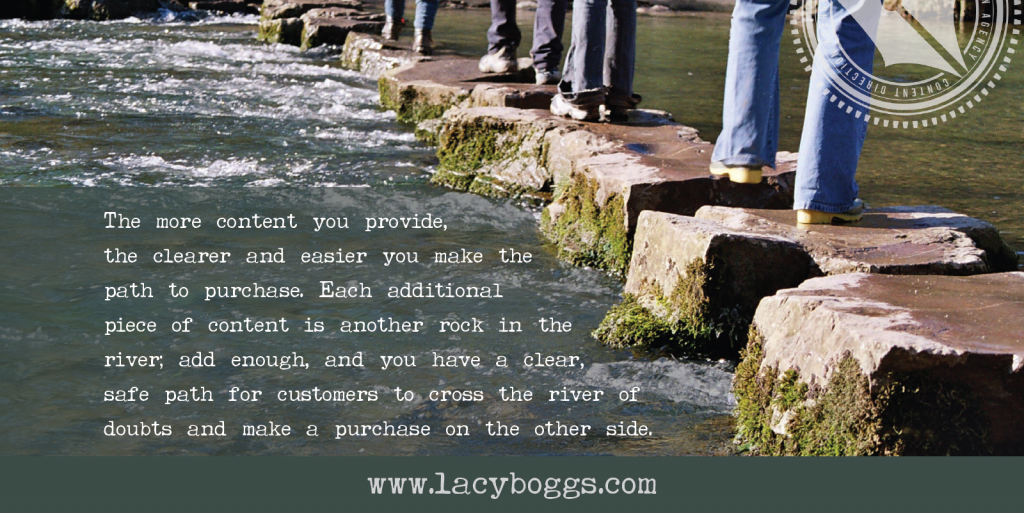How much content do you need to actually launch and sell a product?
It’s a big question. Some internet marketers create tens of thousands of words of content to launch a new product. For example, Ramit Sethi once sent 23 emails over more than a month — 17,000+ words — to sell a course.
That’s serious Jedi-level content marketing, there.
But Ramit also has a team to help him — and not every product or launch requires that volume of content to make good sales.
What I see very often is that new online business owners get overwhelmed by the amount of content they think they need to launch and sell a product. The truth is, I personally have made thousands of dollars off a single email — so the quantity of the content isn’t the key here. Rather, it’s the quality of the message you’re sending out.
While it is fun and useful to be able to “turn on the money machine” and earn thousands of dollars with a single email, the more realistic and smarter way to do it is to plan to use everything in your content arsenal — including blogs, emails, social media, and special events — to create a path that you can lead your potential customers down towards a sale.
The more you practice this, the more likely people are to be ready and willing to buy from you when they reach the destination at the end of the path, namely, your product.
I’ve created a checklist of the basic building blocks of content you need to create a solid path for your customers to go down. Click here to download it for free.
What kind of path will you build?
As I said, you can make sales from a single email, or sometimes even a single blog post. But the reality is that the people who buy from that post are your early adopters and super fans. They are ready and willing to buy before you ever make the offer.
They are also going to be a pretty small percentage of your list. In addition, you can only tap them so many times before they’re tapped out.
Think about the huge lines when a new iPhone comes out. Those people represent the early adopters and super fans for iPhone. And while they make great news stories and images of lines snaking around the block, in reality they’re a very small percentage of Apple’s overall iPhone market. If they only sold to those people, they wouldn’t be nearly so successful.
I like to think of these “one and done” emails like a big rock in the middle of a river. Sure, some of your fans will be able to jump onto that rock and then make it to the other side to make a purchase — but a lot of people aren’t going to risk it.
The more content you provide, the clearer and easier you make the path to purchase. To extend my metaphor, each additional piece of content is another rock in the river; add enough, and you have a clear, safe path for them to cross the river of doubts and make a purchase on the other side.
So, while each of these pieces of content I outline here is technically optional, the more you are able to produce with care, the clearer the path to sales you will be building for your potential customers.
And, as an aside, this idea of building a path to sales works whether you’re selling a physical product or a service, whether you have a product that’s only available for a limited time or whether you’re simply running a promotion or sale on a product that’s always available. It’s nice and versatile like that.
I’ve created a handy-dandy printable checklist of all the launch content listed in this article (with a few bonus tips thrown in) that you can download for free right here.
By downloading it, you’ll also automatically be added to the VIP interest list for my new program, Content Intelligence Academy, and receive a note when the first class is open for enrollment.
Start with a big list building event
I got this idea from the podcast interview I did with Bushra Azhar, when she laid out how she planned a big list-building event eight weeks before she wanted to launch a product. The “duh, why didn’t I think of that” idea here is that you want to get plenty of new people on your list before you ever start selling anything.
The point of this event is not to sell, but to get fresh leads on your email list. Great options include:
- a group challenge
- a giveaway (be aware that lots of people sign up for giveaways — but they may not be your ideal potential customer)
- a webinar
- a video training series
- a free ebook or guide
Whatever you choose, it should relate to the topic of your product. For example, when Bushra was launching her Email Persuasion Sequence, eight weeks before she ran a giveaway offering a year of Ontraport email services. The giveaway was related to her product. Even though she never mentioned the product or launch during the giveaway, she was priming people to think about email.
Pre-launch content
This is really where my zone of genius lies, and what I’ve been preaching here and in my courses for a couple of years now: you can (and should!) use your blog/email content in the weeks leading up to your launch to prime people to be excited to buy from you.
In the four to six weeks leading up to your product launch, promotion, or sale, you want every bit of content you produce to be in service of your eventual sales. That means that every blog post, every email, every Instagram photo and tweet is on the topic of what you will be selling.
It also means that you’re using your content to tease people about what’s coming up and prime them to be ready to buy. I teach much more about this in my course, Content Intelligence Academy, which is launching soon.
(In case you didn’t notice, that previous sentence is an example of the tease and prime I was talking about!)
I also recommend using my AIDA sequence to choose your blog post topics and very deliberately take people by the hand and lead them down your path.
The goal for all of this pre-launch content is not to sell, but to entice people to join a VIP interest list. By encouraging people to opt in to this list, you’ll create a smaller, segmented list of people who have self-selected that they are interested in what you have to offer — and are therefore most likely to buy.
Launch content
Surprisingly, the launch content is actually not nearly as complicated as many people think it is.
Because you spent the time upfront to A) get new people onto your list and B) lead them down the path you’ve built with content, the last few steps to a sale become much, much easier.
Launch content, then, is usually delivered entirely by email, and is speaking directly to people who have already expressed an interest in your product. The goal doesn’t even have to be to make the sale, but to get them to make a decision.
Yup. You read that right. Your goal with these emails is not to sell but to get the reader off the fence to decide yes or no.
And that takes a lot of pressure off of you.
I like to send between four and six emails during the launch period. The first teases the fact that the launch/sale is about to happen and encourages people to get on the VIP list.
Next, you want to reward those early adopters by giving them early access to the launch or sale. This works particularly well when there’s some limit to how many products/services are available: maybe you can only take 10 new students, or you only have so many items in stock. It encourages those VIP people to buy early and makes them feel special. You can also include a “quick decision bonus” for these people to create a sense of urgency if there’s no natural limit to the amount of product you can sell.
Then you announce the sale to your entire list. Remember that the single goal of this email is to get them to open it, and then click through to the sales page, so use lots of curiosity to entice them to want to learn more. (It’s your sales page’s job to sell, not the email.)
Finally, we want to invoke a little FOMO (fear of missing out) and send at least one email warning them that the sale/promotion/launch is about to be over. This is the one email you never ever want to miss, because as much as 50 percent of your sales could come at the last minute.
And that’s it! It doesn’t have to be extremely complicated.
But wait! There’s more…
Finally, I just want to note that your job as a content producer doesn’t end when the launch or sale does. You still need to deliver the product and nurture the customer.
Research shows that your best customers are your repeat customers. And the only way to get repeat customers is to provide your current customers with an excellent experience.
That means you need clear welcome emails, as well as emails offering advice and support as they use your product or service. Think about communicating “before, during, and after” the sale.
Ready to put this system to use for your own business? Don’t forget to download your handy checklist of these content pieces so you can put them to use in your biz.



I have bee online now for many years watching this part of the internet grow. I follow tons of other female entrepreneurs and I have to say this: this post was the best damn piece of business blogging advice I have read!
Thank you so much, LeeAnna! That’s high praise indeed!